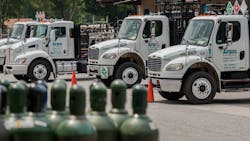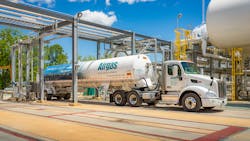Typically, Airgas is one of the first fleets to arrive with essential products for hospitals, refineries, and chemical plants after a hurricane or other natural disaster. “I don’t want to say we drive into the storm, but we’re among the first responders after the storm,” Christopher Sower, vice president of distribution and logistics at Airgas, told FleetOwner.
Last March, Chris Romig, a 10-year Airgas Merchant Gases (AMG) bulk delivery driver and U.S. Army veteran from Canton, Ohio, was the first to volunteer to drive right into another kind of storm: the COVID-19 crisis unfolding in New York City. In the early, uncertain days of the pandemic, as cases and hospitalization rates were spiking in and around New York, hospitals were facing critical shortages of medical oxygen.
But Romig, who was named the company’s AMG Driver of the Year and one of the Top 20 drivers in 2020 among the 5,200 company drivers across all of Airgas’ divisions, was the first to raise his hand when the Airgas executives saw the crisis emerging.
During the height of the COVID pandemic in 2020, Airgas saw its medical oxygen deliveries quadruple in some areas, putting an enormous strain on the company’s infrastructure. “When that took place, there was no shortage of drivers that would volunteer to go out-of-market—and go for long periods of time,” Sower recalled. “Many, not accustomed to teaming up, did it to be more efficient in how we utilized equipment.”
Equipment was in short supply to keep up with the medical oxygen needs in the most critical areas, which at the start of the pandemic were metro New York and pockets of California. “When we thought we might not have enough equipment, we transferred equipment from other areas. We leased available equipment. We converted some equipment that was compatible to move medical oxygen,” Sower said.
When some drivers out West got exposed to COVID and had to quarantine, Airgas NCN fleet manager Dale Harris, who oversees West Coast operations from Northern California and Nevada up to Alaska, faced a potential driver shortage. But instead, the drivers able to work stepped up. “No one complained about having to work extra hours or make extra deliveries or do extra work,” he told FleetOwner. “It was all a big team effort to make sure there was no interruption of service.”
Airgas, which was acquired by France-based Air Liquide Group in 2016, has the largest packaged gas distribution network in the U.S. Airgas ranks 35th on the 2021 FleetOwner 500 Private Fleets list. Its entire fleet, which includes various brands serving a wide swath of industries, is the fifth-largest private fleet hauler of petroleum or gases. Airgas was named one of three finalists for the annual FleetOwner 500 Private Fleet of the Year awards, which were announced during the National Private Truck Council's 2021 conference in Cincinnati on June 15.
Drivers at the forefront
Airgas has facilities and distribution across all 50 states. It is the largest organization in the U.S. that is specifically trained to handle compressed gases and has a hazmat team, the Airgas Emergency Response Organization, trained to respond quickly to emergencies. Beyond oxygen, some of the more popular gases the fleet hauls include argon, nitrogen, acetylene, and carbon dioxide.
“Safety is at the forefront of everything that we do,” Jerry Freeman, Airgas senior director of transportation and fleet safety, told FleetOwner. “It’s very much part of our culture and what we try to convey in our driver and workforce population.”
Any new Airgas driver spends his or her first 90 days working alongside a mentor to learn about the safety culture that is ingrained within the fleet as well as how to work with customers and identify the cylinders that hold gases. “There’s a lot to learn when you’re new to this industry,” Harris explained. “There are thousands of different types of gases, and you have to be able to identify them all and what their hazards are.”
Sower said that driver safety philosophy begins during the hiring process. “It’s not enough for us to just look at whether or not they have a good roadway safety performance record. It’s also a cultural fit,” Sower said. “It’s really about us feeling comfortable that they are going to come in and enhance our safety performance and service performance for the customer. Our drivers are the face of the company to our customer base.”
He added that there is a lot of responsibility when it comes to hauling gases. “We really try to appeal to the greater sense of morality and sense of responsibility to our driver base,” Sower said. “It makes them feel more like they’re part of something that matters as opposed to just a driver job.”
That sense of teamwork was tested—and enhanced—during the pandemic, Freeman said. “COVID required us to relook at what we were doing and how we were doing it,” he explained. “We all adapted quite well to meet the needs of both our customers and the demands of the industry. We’ve gone through the worst of it, and we’re on the other side, all the better.”
About the Author
Josh Fisher
Editor-in-Chief
Editor-in-Chief Josh Fisher has been with FleetOwner since 2017. He covers everything from modern fleet management to operational efficiency, artificial intelligence, autonomous trucking, alternative fuels and powertrains, regulations, and emerging transportation technology. Based in Maryland, he writes the Lane Shift Ahead column about the changing North American transportation landscape.





